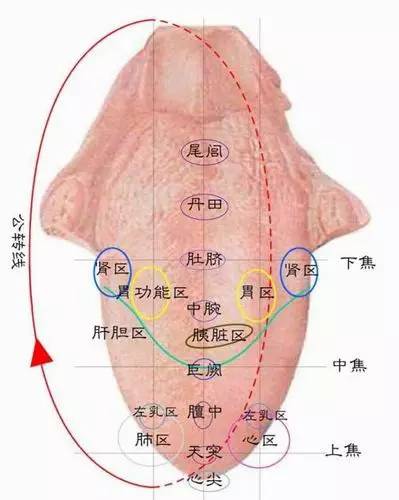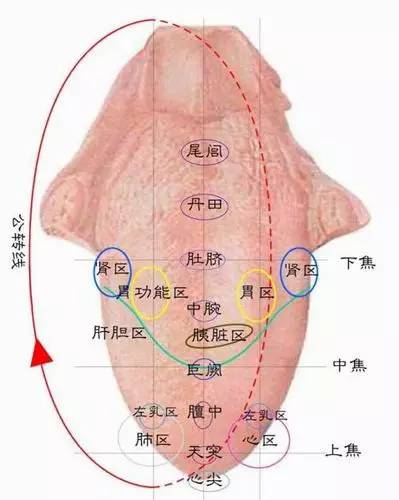
Tongue diagnosis is a technique that can reveal the secrets of the body. Whether it is blood deficiency (xu xue), qi deficiency (xu qi), phlegm-dampness (tan shi), or blood stasis (xue yu), all can be observed the moment you stick out your tongue.
When a cold due to wind-cold (feng han) first arises, if the tongue coating is thick and white, ginger tea for dispelling cold and dampness is most effective; if the tongue coating turns yellow, it indicates that the cold may have transformed into heat, and the treatment should carefully consider whether to clear heat. On days when the tip of the tongue is particularly red, one can try drinking some lotus seed tea to prevent insomnia due to excessive heart fire at night; after a few days of travel, if the spleen and stomach feel uncomfortable, the tongue coating will definitely become thick and greasy, and boiling a pot of five-finger peach (wu zhi mao tao) soup to dispel dampness will prevent future issues;
See, tongue diagnosis is a relatively easy magic to master.
Teacher Luo Dalun, who has studied tongue diagnosis for many years, has published a new book titled “Illustrated Tongue Diagnosis: Stick Out Your Tongue to Eliminate Hundreds of Illnesses,” which is very well explained, and most importantly, even beginners can understand it! The following practical tips on tongue diagnosis are mostly derived from this book, allowing Teacher Luo Dalun to reveal the truth about our tongues.
The most enviable is the “peach blossom tongue”; generally speaking, people with a balanced constitution have the purest tongue appearance, which is a light red color resembling peach blossoms, with a thin white coating. This enviable tongue appearance is referred to as “peach blossom tongue.” If the tongue body is red, it indicates heat; if the tongue body is white, it usually indicates cold.
“Peach blossom tongue” is typically found in individuals with good innate constitution who also pay attention to maintenance; this tongue appearance is rarer than true beauty.

Before observing the tongue appearance, it is important to note:
Do not eat colored foods such as coffee or orange juice; do not observe it immediately after waking up; do not observe it within half an hour after meals; do not observe it after taking antibiotics or chemical additives.
Qi deficiency: Those with sufficient qi and those with qi deficiency look completely different.
The main manifestations of qi deficiency: dull complexion, poor physical strength, easy fatigue | fear of cold, fear of wind, prone to colds, prone to abdominal bloating after eating, and loose stools.
People with qi deficiency often have a swollen tongue.
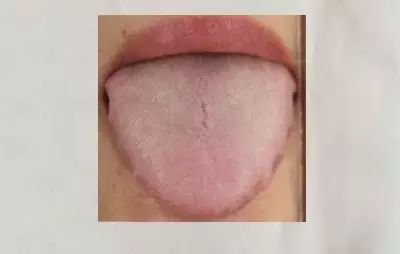
The tongue appearance of qi deficiency:
The edges of the tongue have tooth marks. For those with qi deficiency, the sides of the tongue have tooth marks—imprints from the teeth. This is because people with qi deficiency easily accumulate dampness that cannot be expelled, which over time can lead to swelling of internal organs and skin. If the tongue coating covers the entire tongue without revealing the tongue body, it indicates heavy internal dampness. If the tongue coating becomes thicker, it indicates increasing internal dampness. If the tongue is round and swollen with tooth marks, it often has two saliva lines when extended, indicating heavy internal dampness.
The tongue has cracks in the middle. If the tooth marks on the sides of the tongue are not obvious, but the cracks in the middle of the tongue are very pronounced (everyone has cracks in the middle of their tongue, but in normal individuals, the cracks are not obvious), and even branch out into various types of cracks, it indicates poor spleen and stomach function, insufficient spleen and stomach qi, and inability to lift the tongue coating, resulting in noticeable cracks.
No tongue coating. If there is no tongue coating or the coating is extremely thin, and the entire tongue appears pale, it indicates poor constitution, deficiency of righteous qi, especially insufficient spleen and stomach qi. Individuals with this tongue appearance may be suffering from a serious illness, as the spleen and stomach are affected, leading to the loss of tongue coating. The first step for such individuals is to regulate the spleen and stomach; only when the spleen and stomach qi is sufficient can the body be saved; this tongue appearance may also result from improper diet damaging the spleen and stomach.
Phlegm-dampness: Those with phlegm-dampness are most prone to the three highs.
The main manifestations of phlegm-dampness: overeating, enjoying rich foods, frequently having social engagements, often eating late-night snacks, excessive fluid intake, and poor emotional state.
Spleen deficiency can lead to increased dampness in the body, which can develop into a phlegm-damp constitution. This is because dampness that lingers in the body for a long time can condense into phlegm—liquids in the body gradually evaporate and condense, ultimately forming a viscous substance. Phlegm-damp obstruction is partly caused by lifestyle habits, such as unbalanced diet, excessive consumption of cold foods, and not eating seasonally. However, the root cause is often poor emotional state.
Observing the tongue:
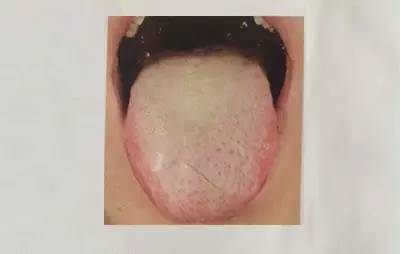
The tongue surface is sticky and not refreshing. If the tongue has moisture and stickiness, making it feel unclean, and the groove in the middle of the tongue is very pronounced, such individuals generally have the “three highs”—high blood pressure, high blood lipids, and high blood sugar. If the tongue coating is slightly yellow, not overly greasy, just beginning to show yellow and greasy, it indicates that this person has started to develop phlegm-dampness; if accompanied by redness in the cheeks, it indicates internal heat that needs to be resolved.
Thick white greasy tongue coating. A common observation is a thick white greasy tongue coating, which cannot be wiped away or scraped off, and is covered with a layer of oily mucus. This tongue appearance often suggests poor spleen and stomach function, indigestion, and frequent issues like diarrhea and stomach pain. Especially in high temperatures and heavy humidity, it is particularly easy to develop a thick white greasy tongue coating.
Thick yellow tongue coating is also quite common. A thick yellow tongue coating indicates internal damp-heat; this tongue appearance is often seen in individuals who enjoy drinking alcohol. If the tongue coating is quite yellow, it may indicate severe internal heat, and at this time, one should drink more cooling teas.
Individuals with a thick white greasy tongue coating can eat more winter melon and ginger; it is recommended to boil a soup with winter melon, coix seed (yi yi ren), yam (shan yao), and ginger, and also use Huo Xiang Zheng Qi water. If the tongue coating is thick and yellow, dietary therapy is not very effective, and one can use some Chinese patent medicines, such as Huang Lian Shang Qing Wan or Dan Zhi Xiao Yao Wan.
If the tongue coating is very greasy and thick, it indicates excessive internal nutrition that cannot be transformed into heat, leading to more serious imbalances. Individuals with this tongue appearance and phlegm-damp constitution should definitely not supplement their bodies further.
The fundamental cause of phlegm-damp constitution is also spleen deficiency, as the spleen is unable to transform and transport water and dampness, leading to prolonged stagnation of water and dampness in the body. Therefore, individuals with phlegm-damp constitution can also frequently drink five-finger peach soup to tonify qi and dispel dampness.
Yang deficiency: Insufficient yang qi, living in fear.
The main manifestations of yang deficiency: fear of wind, fear of cold, especially in the abdomen and lower limbs, pale complexion, lack of blood color, frequent clear urination, large volumes of urine, decreased libido, and abdominal or stomach pain when exposed to cold.
Currently, there are particularly many individuals with yang deficiency, as the body’s warming function is insufficient. The kidneys in the human body can produce kidney yin and kidney yang. Kidney yang is responsible for warming the body, governing reproduction, and supporting our vitality.
Why is there insufficient kidney yang? Excessive consumption of kidney essence, such as staying up late, excessive sexual activity, suffering from serious illnesses (the body consumes kidney yang while fighting disease), and using too many cold medicines, etc.
Observing the tongue:
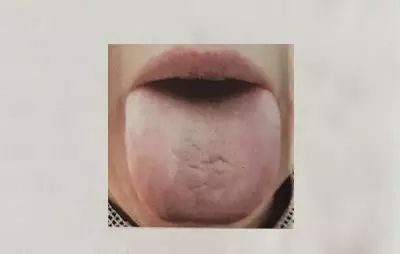
The tongue appearance of yang deficiency is similar to that of blood deficiency, differing in that individuals with yang deficiency have a white tongue coating, a pale tongue body, and the tongue does not appear red, looking relatively “aged”; while the tongue appearance of blood deficiency is pale and tender.
Individuals with yang deficiency, when the deficiency is mild, have heavier internal dampness, so the tongue is more moist, which in TCM is referred to as “water sliding tongue coating”; when the yang deficiency is more severe, the body fluids cannot rise, leading to dry mouth and tongue.
Chinese patent medicines for regulating yang deficiency: For insufficient kidney yang, one can take Jin Gui Shen Qi Wan; for elderly individuals who frequently wake up at night, Jin Gui Shen Qi Wan can also be taken; if one experiences stomach pain upon contact with cold substances, Fu Zi Li Zhong Wan can be taken.
Blood deficiency: Those who do not nourish blood age quickly.
The main manifestations of blood deficiency: dizziness when standing up after squatting for a short time, poor memory, insomnia, some may experience vivid dreams, fatigue, and the body temperature aligns with the external environment.
Currently, there are particularly many individuals with blood deficiency, especially women.
Traditional Chinese Medicine believes that blood is generated after the spleen and stomach absorb nutrients from food. Modern individuals often have many issues with their spleen and stomach, and how do these problems arise? “Overeating!” When the spleen and stomach are damaged by excessive eating, their ability to absorb nutrients becomes impaired, leading to abnormal blood supply.
Currently, the anemia in children is often related to eating too well and too much. Excessive fatigue and worry can deplete heart blood. Various situations of blood loss can also lead to blood deficiency, so the probability of blood loss throughout a person’s life is relatively high.
Observing the tongue:
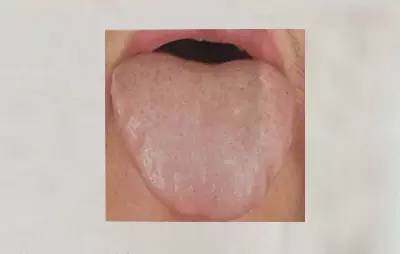
If the edges of the tongue are very pale, it indicates mild blood deficiency. If the tongue coating is not thick, and the color of the tongue body is very light, even somewhat transparent, this is a typical sign of blood deficiency.
Yin deficiency: Most prone to anxiety and internal heat.
The main manifestations of yin deficiency include: irritability, rapid pulse, hot palms and soles, poor sleep, night sweats, dry stools, yellow urine, and soreness in the lower back and knees.
Manifestations of yin deficiency in children:: very red lips, eye bags, prone to colds, and throat swelling, hyperactive, and poor patience.
Individuals with yin deficiency have increasing internal heat. Staying up late, consuming excessive spicy foods, and poor emotional states can all lead to yin deficiency.
Observing the tongue:
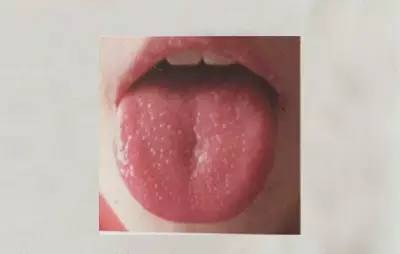
If a person does not have an external pathogen but has a thin or absent coating on the tongue, and the tongue body is red, it can be concluded that this person has a yin deficiency constitution. If the tongue coating is very thin or absent (atrophied), it is also a manifestation of yin deficiency. Many people have geographic tongue, where patches of coating are missing, exposing the red tongue body; this tongue appearance is mostly caused by yin deficiency.
Older adults are more prone to yin deficiency because, with age, body fluids are consumed more, and by old age, they are already scarce, leading to a yin deficiency constitution. From the tongue appearance, elderly individuals often have very red tongues with many deep cracks, and they experience discomfort when consuming spicy foods, all of which are manifestations of yin deficiency.
Most individuals transition from a yin deficiency constitution to a blood deficiency constitution; yin deficiency and blood deficiency are interrelated and can develop into each other. Severe yin deficiency can lead to blood deficiency. There are also many individuals with blood deficiency who originally have pale tongues, and for unknown reasons, their tongues gradually become red, indicating a transition from blood deficiency to yin deficiency.
Qi stagnation: Calming the spirit is essential for strength.
The main manifestations of qi stagnation include:: bitter and dry mouth, dry throat, dizziness, poor appetite, aversion to food, alternating chills and fever, nausea, acid reflux, upward regurgitation of qi, chest tightness, palpitations, abnormal heartbeats, and localized pain in the ribs, insomnia with vivid dreams.
Qi stagnation refers to the stagnation of liver qi, which is the biggest issue for modern individuals. If emotions are not alleviated in a timely manner, prolonged stagnation may lead to diabetes, tumors, and other issues.
Observing the tongue:
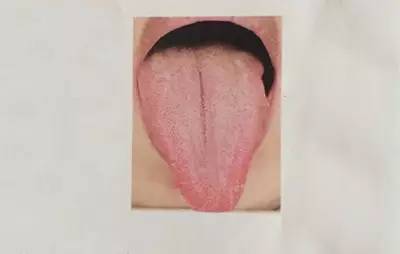
The most obvious characteristic of liver qi stagnation is that the tongue is pointed and red, especially at the tip and edges. This is a manifestation of qi stagnation. If the tongue has a thick white coating that covers the entire tongue but the tip remains pointed, this is also a typical sign of liver qi stagnation.
If the tongue is pointed, with red edges and a red tip, and a thick white coating on top, it indicates that this person has previously experienced liver qi stagnation, which is still negatively affecting their body, and their physical state has not yet adjusted; or this person is currently experiencing liver qi stagnation.
If a newborn has a pointed tongue, parents should be alert to the possibility of qi stagnation in the child.
Blood stasis: Aging is the process of increasing blood stasis in the body.
The main manifestations of blood stasis include: poor memory. Many areas of the body may show bruising, frequent dryness of the throat, dry and rough skin, visible blood vessels, and pain in certain areas of the body.
In addition to trauma, surgery, anger, qi deficiency, and cold exposure leading to blood stasis, “heat” can also cause blood stasis, as “heat” evaporates the liquid in the blood, making it viscous, leading to blood stasis in the body.
Observing the tongue:
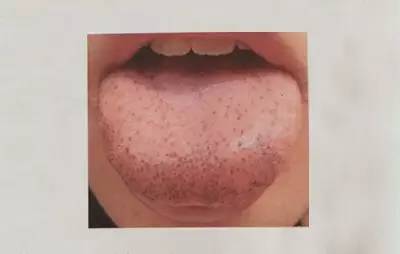
If there are obvious stasis points on the tip of the tongue, it indicates that blood stasis is about to form but has not yet formed. If there are many black or blue stasis points on the tip and sides of the tongue, it indicates severe blood stasis. If the veins under the tongue are dark and thick, it indicates severe blood stasis in the body. If the tongue body is bluish or purplish, it suggests the presence of blood stasis.
Deviated tongue tip. Unless the tongue tip is naturally deviated, which is a physiological condition, if your tongue tip was normal before and has recently deviated, it is important to pay attention to blood stasis. Generally speaking, the direction in which the tongue tip deviates indicates which side of the head has blood blockage. Note that elderly individuals often experience cerebrovascular blockage, so if the tongue direction changes, it is important to take the elderly for a check-up, as their bodies are very sensitive, and cerebrovascular blockage can occur suddenly.
The tongue tip deviation, stasis points, and distended veins under the tongue generally do not appear together. However, if any one of these conditions appears, it indicates the presence of blood stasis in the body; if multiple conditions appear together, it indicates a serious condition.
If a woman has signs of blood stasis on her tongue, and heavy hair growth on her lips, it may indicate endocrine issues, and she should be thoroughly examined for possible uterine fibroids, ovarian cysts, and other problems.
Article excerpt from “Illustrated Tongue Diagnosis: Stick Out Your Tongue to Eliminate Hundreds of Illnesses”
(Luo Dalun)
Editor: Guo Shala


